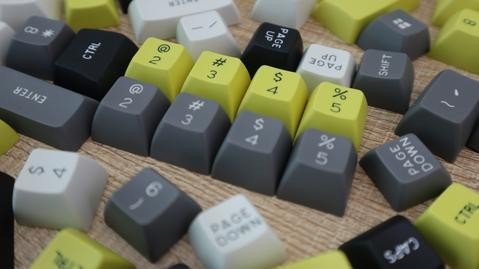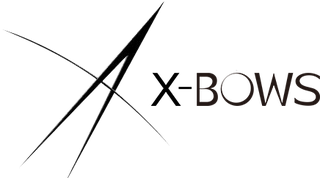
The Ultimate Guide to Keycaps
The Ultimate Guide to Keycaps
We spend a lot of time discussing the switches that we type on. But what about the keycaps- the part of the keyboard that is in direct contact with your fingers? The reality is that not all keycaps are the same and the quality of your keycaps can have a huge impact on your typing experience.
There are tons of important terms when it comes to keycaps- double-shot, ABS, PBT, Pudding(!?). Read below to find out what this all means.
KEYCAP MATERIALS
Keycaps can be made of a number of materials- metal, bamboo, and even wood. But the vast majority are made from plastic. Within the category of plastic, there are a few different chemical structures: ABS (Acrulonitrile Butadiene Styrene), PBT (Polybutylene Terephthalate), POM (Polyoxymethelene), PC (Polycarbonate), and PVC (Polyvinyl Chloride).
What are ABS Keycaps?
ABS plastic is one of the most common in keycaps for mechanical keyboards. It can be made affordably and is semi-durable. Relative to other plastics used for keycaps, ABS has a low melting point. This makes it easier to mold and the preferred choice for double-shot keycaps.
ABS plastic is naturally smooth and can have a slick feel to the touch. It is common to produce ABS keycaps with a textured feel, but over time the texture will wear off. This is why cheaper ABS keycaps will often get a shine or glossy look after extended use.
Legends on ABS keycaps are often pad-printed, laser-etched, laser-engraved, or double-shot. Pad-printed legends will wear off with extended use.
The speed with which an ABS keycap will begin to shine depends greatly on the quality of the plastic materials. Depending on the specific plastic formula, some ABS keycaps can last many times longer than others and can cost many times as much to produce.
White ABS plastic is prone to yellowing when exposed to too much ultraviolet light.
What are PBT Keycaps?
PBT is one of the hardest, most durable materials used in the production of keycaps. It is more resilient to heat and chemicals than other plastics but is notoriously difficult to mold and thus, more expensive to produce.
PBT legends are commonly laser-etched or dye-sublimated. Only very rarely are they made as double-shot because of shrinkage during the demolding process in production.
PBT keycaps tend to be thicker than ABS. Because of this added weight and density, PBT keycaps will sound more thumpy and lower-toned, while ABS will sound more clicky and higher-toned.
Compared to the average ABS keycap, PBT will have a longer usable life and will be more resistant to wearing down or becoming shiny.
Other Plastics- POM, PC, and PVC
POM is a thermoplastic. It is hard and durable, with low friction. It is denser than both ABS and PBT but can have a slick, slippery texture. POM legends are most commonly laser-etched.
PC is fairly uncommon in widely manufactured keycaps. It is most commonly used in clear or translucent keycaps. It is sometimes blended with ABS to make ABS-PC plastic.
PVC is a relatively hard, mid-tier plastic. It is among the least favorable keycap materials because its production has very negative environmental impacts. PVC is largely used in mass-market keyboards and its legends are commonly pad-printed or stickers, though laser printing can also be used.
KEYCAPS MANUFACTURING
A keycap’s material is the most marketable way to differentiate quality but the individual manufacturing processes used in production can have even more of an impact on a keycap’s quality. High-priced plastic is of little value if the key’s legend will fade away quickly.
The way that legends (the letters, numbers, or symbols on a keycap that designate the key’s function) are applied to a keycap is a huge quality differentiator. Lower quality legends will fade or peel from keycaps. This is enough to even the fanciest keyboard look old and ugly. Higher quality keycap production methods will maintain clear, sharp legends for the entire life of the keyboard.
Pad Printing
This is by far the most common method for most inexpensive keyboards. There are a wide variety of ways that the legend is printed onto the keycap, the important distinction is that the dye is simply on top of the keycap. Because of this, pad printed legends are notorious for their rate of wear. The legends will fade or disappear over time.
Laser Printing
Laser printing is gaining popularity and is the second most commonly used manufacturing method, after pad printing. There are three main ways to use lasers in keycap production.
Laser Etching- Also known as charring, this method is most commonly used for light-colored keycaps. It uses a laser to burn the plastic, leaving behind a black legend on the keycap.
Laser Etching with Paint Fill- This method also burns grooves into the plastic. Those grooves are then filled in with colored paint. This is a common method for darker colored keycaps.
Laser Engraving- This is the most common way to produce backlit keycaps. A transparent keycap is covered in black paint, then the legend is engraved, allowing backlighting to shine through.
Dye Sublimation
Dye sublimation or dye-subbed is an alternative to printing and is commonly used on PBT keycaps because of their higher heat resistance. The dye is pressed shallowly into the keycap through heating.
Double Shot Keycaps
Double shot injection molding is the most expensive and complex process. In this method, the keycap is produced by first forming one section of the keycap in a mold, then, another colored plastic is added to make up the rest of the keycap. This allows two colors to be used to form a single keycap.
Since the legend and surrounding keycap are both individual pieces of plastic, they wear at the same rate and the legends won’t rub off over time.
Double shot production is mainly used with ABS plastics but there are some double shot PBT keycaps beginning to emerge.
KEYCAP PROFILES
The different shapes of keycaps on a keyboard are known as their profiles. There are many, many different keycap profiles and the details go beyond the scope of this article.
Briefly, keycap profiles can be divided into flat vs. sculpted. Sculpted keycaps were designed for ergonomics and conform more to the natural heights and angles of your fingers for each row of keys. The best-designed sculpted keycaps will also make an effort to prevent your finger from brushing against other rows when you press a key.
Q & A
-
Do Cherry MX keycaps work with Gateron Switches?
Yes, most switch manufacturers have adopted the Cherry MX cross stem. If a keycap works with Cherry switches, it will also work with Gateron, Kailh, Outemu, Razer, and other Cherry MX clones.
-
WHAT KEYCAPS ARE THE BEST?
As with most things in the world of mechanical keyboards, which keycaps are best for you comes down to personal preference. PBT keycaps, on average, will have the longest lifespan. Double-shot labels will be most resistant to fading. Sculpted keycap profiles tend to be more comfortable and ergonomic than flat profiles. You will need to balance which pros and cons are most important to you when you are choosing keycaps to suit your own tastes, needs, and budget.







